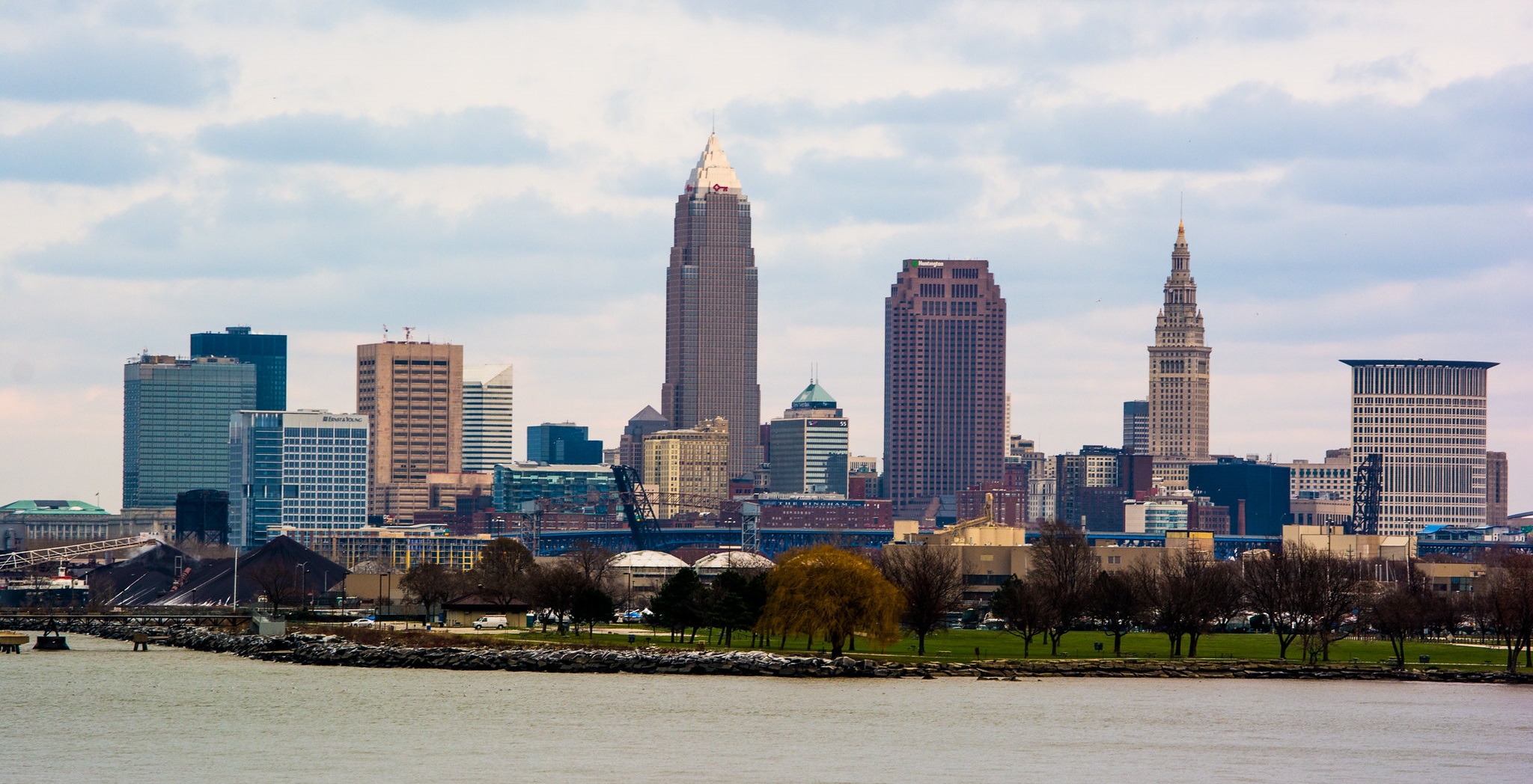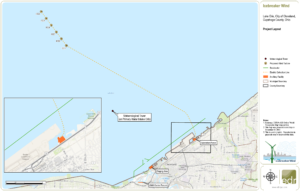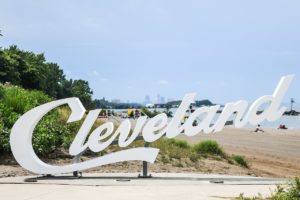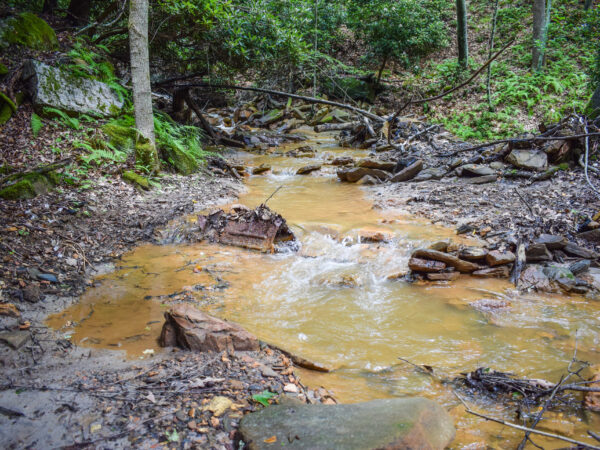
Depending on the person asked, Cleveland could be looking at six wind turbines off Lake Erie’s shore, thousands of them or none at all.
The project, called Icebreaker Wind, would be the first off-shore, freshwater installation in the U.S. Though the initial proposal involves six turbines, critics have pointed out both that approving these could lead to many more and that many residents have no idea that this project is even in the works.
Yet many others disagree and support the project.
The project comes from the Lake Erie Energy Development Corp (LEEDCo), a non-profit, public-private regional economic development partnership. Icebreaker, priced at $126 million, is as near to getting the final green light as it’s ever been. If it receives the go-ahead from the Ohio Power Siting Board (OPSB), it would likely begin construction next year.
LEEDCo’s planning has been in the works since 2009, with a first application in 2013, when intentions to build a site were first submitted to the OPSB. The plans for the wind farm have since been championed by villages, cities and counties as well as dozens of other organizations and entities.
Among them are the cities of Cleveland, Avon Lake, Euclid, Lakewood and Lorain. According to LEEDCo, supporters also include U.S. Rep. Marcy Kaptur, U.S. Sen. Sherrod Brown and dozens of labor, municipal and business groups.
Icebreaker just one more step toward 100 percent green energy for Cleveland
Jocelyn Travis heads up Sierra Club’s Ready for 100 campaign in Cleveland. The lakeshore city is on the road to being a 100 percent green energy city by 2050. In fact, Travis said, Lake Erie wind would be an important part of it.
“We were the 83rd city in the U.S. to make that commitment,” she said. “We’re hopeful and we’re going to do everything we can to make sure we do it. I think it’s a great first step in Cleveland to reach the goal.”
“The concerns about birds and wildlife, that’s a concern and that’s understandable and that’s what’s holding up the process,” she said. “My understanding is the parties have come to an understanding.”
Travis said it’s important to her, and all the organizations, that wildlife isn’t harmed.
On May 15 Sierra Club and the Ohio Environmental Council submitted a Revised Joint Stipulation spelling out details of the nearly three dozen requirements for the project. The 20-page document lists actions LEEDCo must take during the construction and operation of the turbines. That approval includes LEEDCo’s adherence to a small army of rules designed to protect birds, bats and other wildlife.

Illustration showing the projected size of the turbines and towers, Illustration by leedco.org via Gary Wilson
“I think it’s important to note that across the country there is a movement to go clean energy 100 percent and I’m just glad that Cleveland has stepped up and is moving in the right direction,” Travis said. “Especially with this being the 50th anniversary of the Cuyahoga River’s burning and our efforts to clean up the environment.”
Icebreaker technology “experimental” and “unproven”
Mark Shieldcastle, research director at Black Swamp Bird Observatory, located at Magee Marsh Wildlife Area on Lake Erie, said Black Swamp is 100 percent opposed to Icebreaker.
“We’ve had quite a bit of input on that, and our position has to do with the science, or lack thereof. The science that has been done does not meet the criteria to make a judgement on risk,” he said. “There is no effective way of looking at bird or bat mortality.”
The reason, Shieldcastle said, is that being situated over open water eliminates the possibility of recovering any birds or bats injured or killed in collisions. The technology required to be in each turbine blade could in theory detect objects struck, but not the species, age, sex or other important data, he said.
“Bats don’t even have to hit the blades,” he said. “It’s called barotrauma, which is a quick change in barometric pressure as the blade goes by them. Basically it explodes their lungs. That’s the kind of issue LEEDCo’s technology will not answer.”
Shieldcastle said he believes the bird strike technology which Icebreaker will feature is still in experimental stages and is unproven, and complete environmental impact determinations still need to be completed before any decisions are rendered.
Skeptics say six turbines just the tip of the spear
LEEDCo’s claim of more than 500 jobs and more than $168 million in economic impact in the region doesn’t hold water, according to John Lipaj, Lake Erie Foundation board member. He described the jobs as temporary, with just a handful of permanent jobs after the turbines are erected.
“Our position is that Lake Erie is too precious a natural resource to place wind turbines on the lake until there’s a full environmental impact study that looks into all the implications of placing, what will most likely end up being thousands of wind turbines, on the lake,” he said.
And that fact seems to be lost on most, according to Lipaj. Roughly half the people he spoke to at boating events in Port Clinton and Cleveland had no knowledge of wind turbines going into Lake Erie, and the other half were only aware of the six turbines, he said.

Map illustrating where the turbines would be located in relation to downtown Cleveland, Illustration by leedco.org via Gary Wilson
“The other half said ‘Yeah, we heard something but it’s only six wind turbines, so what’s the big deal?’ And that was consistent at two boat shows in talking to hundreds of people,” he said.
“When confronted with the facts, everybody we talked to said they didn’t know any of this,” Lipaj said.
Lipaj pointed to a 2013 interview which appeared on the FreshWaterCleveland.com website, where LEEDCo Vice President of Operations Dave Karpinski spelled out plans:
Long term, this is about more than this one project. In a couple of decades, we want to implement 5,000 megawatts of wind energy in Lake Erie. Getting this first project built can turn into momentum for more activity.
In an email statement, LEEDCo dismissed the idea of even discussing future turbines. “We are concentrating on the Icebreaker Wind project at this time. Speculating about additional turbines years from now is hypothetical and dependent upon many factors – including the separate, long and involved process of earning approval.”
Lipaj said he and two others, one a private boater and another a Lake Erie activist met with the The (Cleveland) Plain Dealer editorial board for about two hours recently.
“We pointed out there’s very little public awareness on this, most people think it’s just six wind turbines. And they said ‘Oh no, we’ve done a lot on this and we can’t understand why there’s no public awareness on this.’ In the end, it became clear to us why, because they want to see this happen. The head of the editorial board made it clear they’ve met with LEEDCo, and they like what LEEDCo has to say,” Lipaj said. “I think they know the more the public knows about this, the more they’ll be against it.”
Turbines could impact lake-related tourism
Ottawa County Commissioner Mark Stahl is sort of stuck in the middle. While he believes wind power is a good thing, he doesn’t necessarily want to see it go head-to-head with already-existing local power.
The Davis Besse Nuclear Plant is a major economic engine in the region and his county. But the plant’s future is up in the air: mostly because it can’t compete against the surging natural gas industry on price.
“Obviously when the wind blows we can make power with turbines and when the sun shines we can make power with solar,” Stahl said. “But I don’t think we need to look at nuclear and wind and solar as competitors more than companions working during the future transition. But as of now, we need the on-going base-load that powers us 24 hours a day, seven days a week.”
Stahl described nuclear power as clean and reliable, with the added benefit of making a small footprint, land-wise.
But Stahl wasn’t enthusiastic about making negative comments on the prospect of wind turbines in the lake, even though his constituents’ economy relies largely on lake-related tourism. Instead, he offered up reservations about the sheer amount of space required for Lake Erie turbines.
“Wind turbines, especially if it goes to scale, far beyond the six, would take up a lot of space to produce the same energy as a gas or nuclear plant,” he said.
And aesthetics on the lake?
“It could be a concern,” Stahl said.
“We all have to make changes for the greater good”
“Many people oppose it solely on aesthetics, and I understand people liking things the way they are, but we all have to make changes for the greater good,” said Jane Harf, director of Green Energy Ohio, an advocacy group that promotes zero-carbon energy. “There are plenty of people who question the technology, but I think it’s proven and they’ve received all the permits. So we at GEO believe they’re doing everything necessary to ensure there is safety and minimal environmental impacts.”
Harf said she doesn’t believe aesthetics will win, as an argument.
“I think a lot of times, what it comes down to is what inconveniences us personally,” she said.
Travis said she doesn’t see a problem with aesthetics, and that in fact, the site of wind turbines off-shore makes the city, and the state, appear progressive. And that’s fine with her.
“It makes it looks like we’re coming into the 21st century and that we care about the health and welfare of our community. I see it only as a positive,” she said.
Major Lake Erie trades group says “no” for now
Ken Alvey spent decades representing Lake Erie boat dealers, the recreational marine industry and Lake Erie, as president of the Lake Erie Marine Trades Association. Recently retired, he now serves as an industry advisor and spokesman for the group. He is also among Icebreaker’s detractors.
“There’s been a lot of things we’ve taken positions on environmentally over the years, like not drilling for gas beneath Lake Erie for one, and this happens to be another one of them,” he said. “Our initial reflection has to do with the science. It’s a demonstration project and has the potential to expand this to a fleet of wind turbines on Lake Erie and so in our case we’re very interested in an environmental impact statement, and it hasn’t had one.”
Alvey said he’s heard this could lead to 1,500 turbines in Ohio waters, and he read a study that said wind turbines are bad for tourism.
“Of course there are different studies that each party has taken to,” he explained. “Some are saying one thing and others something else. It’s kind of like the Trump dossier, people are saying different things about the same report.”
Alvey said he’s particularly interested in knowing how turbines might affect fish, especially walleye and yellow perch, the lake’s most-prized residents.
“We’ve heard some discussions about impact to aviary and fisheries they would create, and obviously the fisheries portion is really important to us,” he said.
Project still under review by officials, with no set timeline
Ann Marie Gorman, a fisheries biologist at the ODNR’s Fairport Harbor Fisheries Station said LEEDCo has been, and will be, looking closely at how the project might affect fish in the lake.
“They’ve been doing aquatic sampling and trawling, which is before, during and after construction, and they’re working on some hydro-acoustic data,” she said. Fish that have been tagged with acoustic telemetry transmitters will be watched closely to see if turbines affect behavior. “We don’t know yet if turbines could affect current, but that’s why we’re going to be monitoring current as the structures are installed. So the thought behind a sampling of six turbines is, if you scale it up to more turbines could the impact be broader?”
LEEDCo officials say they have thus far received approvals from 14 local, state and federal agencies, the most recent being in March when the U.S. Army Corps of Engineers approved a construction permit. In total, LEEDCo officials say, they’ve participated in more than 400 project meetings.
Erin Hazelton, an Ohio Division of Wildlife biologist, said because the project is still under review by the OPSB, she can’t offer much information.
“I can tell you it is still going through the process and there is a lot of back and forth, obviously. The OPSB has not seen the information or the conditions that will go into the certificate,” she said. “The certificate is needed for the project to operate. The OPSB is the entity in Ohio that issues them for any commercial-scale energy project.”
Hazelton said the Ohio Department of Natural Resources assessments, with respect to wildlife, will be factors in the OPSB’s final decision.
The board is comprised of seven voting members, including directors of the Ohio departments of health and agriculture, the ODNR, Ohio EPA, Ohio Development Services Agency, Public Utilities Commission of Ohio and one member of the public. As a member of the OPSB, ODNR Director Mary Mertz will soon weigh in on Icebreaker with her vote. She spoke briefly on the issue to a group of outdoor writers recently.
“There’s a lot of energy policy implications and a lot of conservation implications from a lot of perspectives,” Mertz said. “There’s the aesthetics, there’s protection of birds versus energy policy issues. So there’s a lot out there. I would not want to pre-judge, I need to wait until the facts are put before the board,” she said.
Mertz said there is no set timeline for the board’s final vote.
An evidentiary hearing has been scheduled for August 20 at the Ohio Power Siting Board offices in Columbus.
Featured Image: Downtown Cleveland shoreline, Photo by Tim Evanson via flickr.com cc 2.0
6 Comments
-
The permit application to the OPSB is by Icebreaker Windpower, Inc which is owned by the Norweigian company Fred.Olsen Renewables. This means a foreign company is being given leasing rights for the project in the lake bottom and surface waters are supposed to be used by the general public under the Public Trust Doctrine. LEEDCo has received (so far ) $ 50.7 million dollars in grant awards from the U.S. Department of Energy including the most recent grant of $ 40 million dollars from the Trump Administration.
Some 1,600 pages of the permit application have been marked confidential and are not available for the public and media to review and analyze. No scientific, independent studies of the effect on fish and other aquatic animals have been conducted. The state and federal government have not analyzed the viewshed problems this project and the buildout represent a to the public and home owners. They failed to address the problems that industrial wind turbines (which were much smaller ) in the offshore study by Robert G. Sullivan and others of the Argonne National Laboratory found in their review of offshore wind turbines in the U.K.
See Save Our Beautiful Lake and Great Lakes Wind Truth for more information about this horrible, unnecessary project leading up to the destruction of Lake Erie. -
I’ve seen wind turbine farms as I’ve traveled through other states. They are hideous and I’ve read that the ongoing noise/humming has had ill effects on people living near them and on the wildlife. Once they get 6 in the water, there will be many more to follow. I’ve also heard differing opinions as to their worth. How will these affect humans and wildlife? How many permanent jobs will these actually provide? Without using data from a biased source, do these actually provide amounts of energy that justify the great costs (monetary and otherwise) to install these along a shore line? Are underwater turbines, using the power of the water currents, being studied? Follow the money to find the source of those who would back this project.
-
I also wonder about the lifespan of these turbines. Who will be responsible for tearing them down and disposing of them when their viable life ends? Why can’t we use underwater turbines that use the movement of water currents to collect energy? It’s not “just aesthetics” that causes people to want to step back and think about this program. Everyone wants clean energy solutions but this seems to be a matter of asking forgiveness instead of asking permission. Slide it through as quickly as possible before everyone can have an educated opinion. I’d like to see an unbiased report as the the effectiveness of these turbines in creating energy. It’s easy to point at the people who want to think about a subject and call them naysayers who don’t want anything to change. Why is this the only viable solution?
-
I’m puzzled by the comments — these turbines are too far away from population centers to bother with noise or unsightliness, and, based on other offshore turbines, have little effect on wildlife. They will certainly produce electrical power without carbon dioxide, air pollution, or radioactive waste.
-
You will drive tons of business into Cleveland, just in the crews coming her to build and install. Restaurants and hotels will be filled. Materials sold by the ton. parts, tools. The turbines had HUGE. You cant SEE them from your house off shore. We Heard 10 Miles out. You cannot SEE anything 10 miles out. Look at the study for job production. How can burning coal at plant son the rivers and lake be BETTER than wind turbines? We should put all we can. Look at what we are doing now. Coal burning on the Lake and the river. Europe is far less polluted due to wind. turbine energy. Get out of the storage! It’s long past time to do this project.
-
Don’t tell me we won’t see them. I can see the Canadian turbines.






